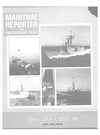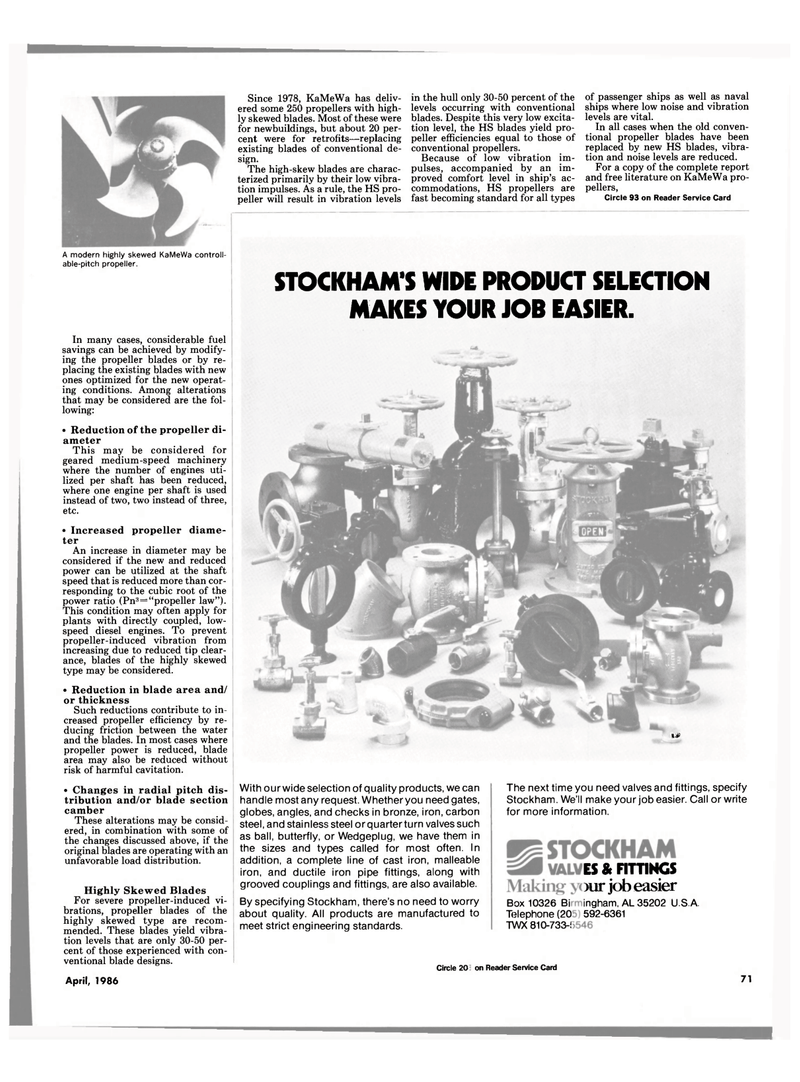
Page 67: of Maritime Reporter Magazine (April 1986)
Read this page in Pdf, Flash or Html5 edition of April 1986 Maritime Reporter Magazine
A modern highly skewed KaMeWa controll- able-pitch propeller.
In many cases, considerable fuel savings can be achieved by modify- ing the propeller blades or by re- placing the existing blades with new ones optimized for the new operat- ing conditions. Among alterations that may be considered are the fol- lowing: • Reduction of the propeller di- ameter
This may be considered for geared medium-speed machinery where the number of engines uti- lized per shaft has been reduced, where one engine per shaft is used instead of two, two instead of three, etc. • Increased propeller diame- ter
An increase in diameter may be considered if the new and reduced power can be utilized at the shaft speed that is reduced more than cor- responding to the cubic root of the power ratio (Pn:i = "propeller law").
This condition may often apply for plants with directly coupled, low- speed diesel engines. To prevent propeller-induced vibration from increasing due to reduced tip clear- ance, blades of the highly skewed type may be considered. • Reduction in blade area and/ or thickness
Such reductions contribute to in- creased propeller efficiency by re- ducing friction between the water and the blades. In most cases where propeller power is reduced, blade area may also be reduced without risk of harmful cavitation. • Changes in radial pitch dis- tribution and/or blade section camber
These alterations may be consid- ered, in combination with some of the changes discussed above, if the original blades are operating with an unfavorable load distribution.
Highly Skewed Blades
For severe propeller-induced vi- brations, propeller blades of the highly skewed type are recom- mended. These blades yield vibra- tion levels that are only 30-50 per- cent of those experienced with con- ventional blade designs.
Since 1978, KaMeWa has deliv- ered some 250 propellers with high- ly skewed blades. Most of these were for newbuildings, but about 20 per- cent were for retrofits—replacing existing blades of conventional de- sign.
The high-skew blades are charac- terized primarily by their low vibra- tion impulses. As a rule, the HS pro- peller will result in vibration levels in the hull only 30-50 percent of the levels occurring with conventional blades. Despite this very low excita- tion level, the HS blades yield pro- peller efficiencies equal to those of conventional propellers.
Because of low vibration im- pulses, accompanied by an im- proved comfort level in ship's ac- commodations, HS propellers are fast becoming standard for all types
Box 10326 Bi
Telephone (20
TWX 810-733-!
Circle 201 on Reader Service Card of passenger ships as well as naval ships where low noise and vibration levels are vital.
In all cases when the old conven- tional propeller blades have been replaced by new HS blades, vibra- tion and noise levels are reduced.
For a copy of the complete report and free literature on KaMeWa pro- pellers,
Circle 93 on Reader Service Card
ES & FITTINGS >ur job easier ingham, AL 35202 U.S.A. 592-6361
STOCKHAM'S WIDE PRODUCT SELECTION
MAKES YOUR JOB EASIER.
MP
With our wide selection of quality products, we can handle most any request. Whether you need gates, globes, angles, and checks in bronze, iron, carbon steel, and stainless steel or quarter turn valves such as ball, butterfly, or Wedgeplug, we have them in the sizes and types called for most often. In addition, a complete line of cast iron, malleable iron, and ductile iron pipe fittings, along with grooved couplings and fittings, are also available.
By specifying Stockham, there's no need to worry about quality. All products are manufactured to meet strict engineering standards.
The next time you need valves and fittings, specify
Stockham. We'll make your job easier. Call or write for more information.
April, 1986 71

 66
66

 68
68
